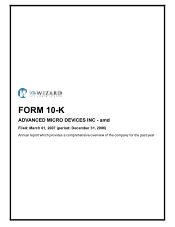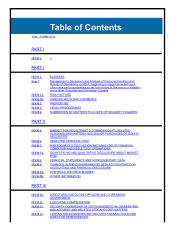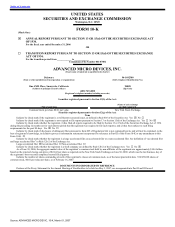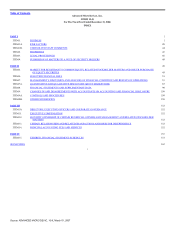AMD 2006 Annual Report Download - page 11
Download and view the complete annual report
Please find page 11 of the 2006 AMD annual report below. You can navigate through the pages in the report by either clicking on the pages listed below, or by using the keyword search tool below to find specific information within the annual report.
Table of Contents
performance-per-watt by maintaining the performance of the previous generation of AMD Athlon 64 X2 dual-core processors and reducing power consumption.
To aid in reducing power consumption, these new processors incorporate a feature called “C1 Enhanced,” a power management feature that slows selected
system functions when not in use to reduce overall power consumption.
On October 25, 2006, we completed our acquisition of ATI. We believe that the acquisition of ATI will allow us to deliver products that better fulfill the
increasing demand for more integrated computing solutions. We plan to deliver a range of integrated platforms to serve key markets, including commercial
clients, mobile computing, and gaming and media computing. We believe that these integrated platforms will bring customers improved system stability, better
time-to-market and increased performance and energy efficiency. We also plan to develop and offer monolithic silicon solutions for specialized uses that are
comprised of microprocessors, graphics processors and video processors. We refer to these design initiatives as “Fusion.” At the same time, we plan to continue
to develop discrete microprocessor and graphics processor products and to maintain open interface and software standards in order to allow our customers to
choose the combination of technologies that best serve their needs.
Embedded Products
The Embedded Processor Market
During 2006, we offered embedded microprocessors for high end commercial markets, commercial client markets and certain consumer markets. The high
end commercial markets that we address include communication servers, networking equipment, storage servers, and imaging systems. The applications in these
markets typically require high-performance, enterprise-class products that include embedded server-class products. Customers use commercial client products to
address specialized needs within a variety of industries, including computer devices such as thin clients, single board computers, blade PCs, points of sale
terminals, commercial value clients, and access devices such as gateways and access points. Devices for specific consumer markets are used in ultra mobile PC’s,
ultra value clients and entertainment devices such as media players and set top boxes. The applications in these devices typically require highly integrated
systems-on-chip, or SoCs, that include high-performance, low-power embedded processors and microcontrollers.
Embedded Processors
Our products range from low-power x86 architecture-based embedded processors to high-performance, enterprise class, harsh environment-capable x86
architecture-based products. We design embedded connectivity devices to address customer needs in non-PC markets where low power, Internet connectivity
and/or low power processing is a priority. Typically these embedded processors are used in products that require high to moderate levels of performance where
key features include low cost, mobility, low power and small form factor. We target some products that use our embedded processors for specific markets using
SoC design techniques.
Our embedded microprocessor products include the AMD Geode™ product family. AMD Geode microprocessors are 32-bit processors based on the x86
instruction set architecture. These processors integrate functionality such as processing, system logic, graphics, audio and video decompression onto one
integrated device. We also offer embedded processors based on AMD64 technology, which consists of low-power versions of our AMD Athlon, AMD Turion,
AMD Sempron and AMD Opteron families of products. These low power products deliver the same performance as their corresponding full power parts while
offering the added benefit of reduced power consumption and thermal output. These processors are configured specifically for demanding embedded applications
traditionally served by custom silicon designs. We believe these processors also offer our customers the ability to leverage the AMD64 infrastructure. In addition,
a distinguishing characteristic of our AMD64-based embedded processors is our AMD64 Longevity Program. The AMD64 Longevity Program offers a select set
of AMD64 processors with an extended standard availability period of five years. The extended availability period addresses the requirements of customers
designing products for network, storage, blade and
6
Source: ADVANCED MICRO DEVIC, 10-K, March 01, 2007
























